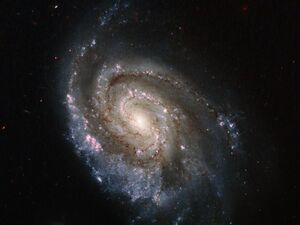Astronomy:NGC 6984
Coordinates: ![]() 20h 57m 53.987s, −51° 52′ 15.13″
20h 57m 53.987s, −51° 52′ 15.13″
| NGC 6984 | |
|---|---|
 NGC 6984 taken by the Hubble Space Telescope | |
| Observation data (J2000 epoch) | |
| Constellation | Indus |
| Right ascension | 20h 57m 53.987s[1] |
| Declination | −51° 52′ 15.13″[1] |
| Redshift | 0.015386[1] |
| Helio radial velocity | 4577 km/s[1] |
| Distance | 180 million ly[2] |
| Apparent magnitude (V) | 12.65[1] |
| Apparent magnitude (B) | 13.19[1] |
| Characteristics | |
| Apparent size (V) | 1.403 x 1.038 arcmin[1] |
| Other designations | |
| ESO-LV 235-0200, 2MASX J20575398-5152151, [CHM2007] LDC 1431 J205753.98-5152151, AM 2054-520, IRAS 20543-5203, PSCz Q20543-5203 [SLK2004] 1671, APMBGC 235+046+104, IRAS F20543-5203, QDOT B2054196-520349, 6dFGS gJ205754.0-515215, ISOSS J20578-5152, SGC 205419-5203.8, ESO 235-20, LEDA 65798, [CHM2007] HDC 1131 J205753.98-5152151 | |
NGC 6984 is a barred spiral galaxy located 180 million light years away in the constellation Indus.
It is known for having been the host of two recent supernovae: one in 2012 first known as SNhunt142[3] (later designated SN 2012im[4]), and one in 2013 known as SN 2013ek. The first was a Type Ic[5] and the second was a Type Ib/c.[6] HST observations were initiated by Dr. Dan Milisavljevic.[7] NASA's press release about SN 2013ek said:
"It is so close to where SN 2012im was spotted that the two events are thought to be linked; the chance of two completely independent supernovae so close together and of the same class exploding within one year of one another is a very unlikely event. It was initially suggested that SN 2013ek may in fact be SN 2012im flaring up again, but further observations support the idea that they are separate supernovae — although they may be closely related in some as-yet-unknown way."[8]
Gallery
References
- ↑ Jump up to: 1.0 1.1 1.2 1.3 1.4 1.5 1.6 "Search Results for NGC 6984". Astronomical Database. SIMBAD. http://simbad.u-strasbg.fr/simbad/sim-basic?Ident=NGC+6984.
- ↑ "Stellar explosions in NGC 6984". ESA/Hubble Picture of the Week. http://www.spacetelescope.org/images/potw1344a/.
- ↑ "ATel #4300: PESSTO spectroscopic classification of optical transients". http://www.astronomerstelegram.org/?read=4300.
- ↑ http://www.cbat.eps.harvard.edu/iau/cbet/003600/CBET003607.txt [bare URL plain text file]
- ↑ "ATel #5225: A new SN suspect at the position of SNhunt142 discovered 1 year ago". http://www.astronomerstelegram.org/?read=5225.
- ↑ "ATel #5227: Spectroscopic classification for PSN J20575390-5152245 with FLOYDS at Faulkes Telescope South". http://www.astronomerstelegram.org/?read=5227.
- ↑ "13505 Program Information". http://www.stsci.edu/cgi-bin/get-proposal-info?id=13505&observatory=HST.
- ↑ Hubble Catches Stellar Explosions in NGC 6984, NASA, 13 November 2013, http://www.nasa.gov/content/goddard/stellar-explosions-in-ngc-6984/#.UoOpbJTXiBM
External links
 |


